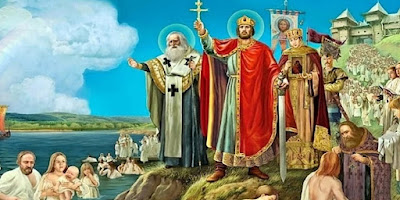The account of the Primary Chronicle is that he looked for the best religion of the three major ones (Christianity, Judaism, Islam) to submit to, settling on Christianity because it didn't have the dietary prohibitions of the others. The Chronicle also contains what is called the "Korsun Legend." In it, Vladimir captures Korsun—part of the Byzantine Empire—in the Crimean Peninsula. He uses this to negotiate with the Emperor Basil II for Basil's unwedded sister in marriage. Vladimir already had a few wives, but this would be the highest-born wife he could get, and forge an alliance with a large empire. Basil consents if Vladimir will be baptized a Christian. He does so, and marries Anna Porphyrogeneta.
Several Arab sources cast this event in a slightly different light. They tell us that two rebels joined forces against Emperor Basil, one of whom actually declared himself emperor in September 987. Basil wanted help dealing with them, and so turned to Vladimir, despite their less-than-friendly history. Vladimir offered his help in suppressing the rebels, in exchange for Anna's hand in marriage. Vladimir also agreed (although he seemed to have had the upper hand in this deal) to be baptized and to Christianize his whole nation. Once this agreement was finalized, Vladimir sent 6000 troops to Basil's aid.
Whichever version is accurate, Vladimir married Anna, but had a problem at home: several wives. He had to divorce Rogneda (who entered a monastery), Adela, and Malfrida. He also had all the residents of Kyiv meet him at the Dnieper River for a mass baptism. He baptized his children and all the nobility. Messages went to all residents of Kyiv to come to the river and be baptized or be declared Vladimir's enemy. Priests from Korsun performed the ceremony.
Afterward, less than a decade after setting up shrines and temples to pagan deities to please the various tribes, he had them all torn down or burned.
In our high school History of Western Civilization classes we often hear about entire countries being forced into Christianity. We never hear about paganism fighting back. In this case, let's see how Vladimir's people felt about their forced conversion. See you tomorrow.
*The Russian attack of Ukraine in 2022 has resulted in a change in many places to use the Ukrainian spelling "Kyiv" over the Russian "Kiev." I still use "Kievan Rus" because it is historically what the group has been called; when I mention the capital city, I will use the Ukraine spelling.



